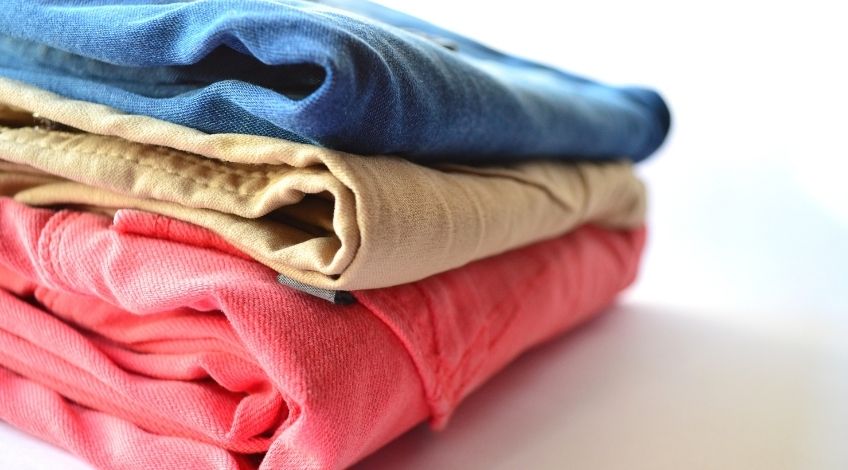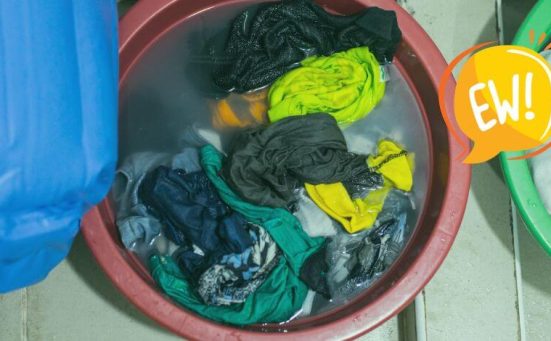
Does Spin Drying Damage Clothes? (& what to do)
The short answer to this question is yes, spin drying does damage clothes, but only if you use the spin cycle incorrectly. Almost all washing machine programmes finish with a spin cycle to remove excess water from the laundry and make it easier to dry either on a washing line, airer or in a tumble dryer. Even if you hand wash your clothes, it’s possible to put them in the washing machine to run a spin cycle to remove excess water.
Most modern washing machines have been designed to operate automatically. Which means they have different programmes and cycles depending on the materials you are washing. Many of these programmes are preset with the correct spin speed.
With that said it’s possible to alter the spin speed manually so that the drum spins at a different speed.
But does spin drying damage your clothes? To answer this fully we need to look at how the spin cycle works on a washing machine, and also run through the types of clothes that you are trying to spin dry.
How Does The Spin Cycle Work?
To remove excess water left in the laundry after running through a wash and rinse cycle, the drum spins at high speed. This speed is measured by how many turns the drum makes every minute and is measured in revolutions per minute (RPM).
The faster the drum spins, or the more RPMs, the more water is removed. This is due to centrifugal force, as the drum spins the washing gets forced against the sides of the drum. This fast spinning action forces the water from the fabric.
What Spin Speed Is Best?
The spin speed set for each programme is based on the fabric the garments are made from. In general terms, the more delicate the fabric, the slower the spin speed.
| Fabric Type | Recommended Spin Speed |
|---|---|
| Silk (and other delicates) | 400 to 600 RPM |
| Wool | 600 to 800 RPM |
| Synthetics | 800 to 1000 RPM |
| Denim | 800 to 1000 RPM |
| Cotton | 1400 to 1600 RPM |
The above speeds are the recommended spin speeds for various laundry items in general terms. However, you should always consult the wash care label for further specific instructions.
On most washing machines, whatever programme you select will have a default spin speed. For example selecting the delicate programme will usually set the spin speed at 600 RPM and so on.
Will Spin Drying Damage Clothes?

In some cases, spin drying can cause damage to clothes. The reasons that spin drying damages clothes usually falls into 5 categories. Which are;
- Clothes Get Tangled
- Clothes Stretch
- Too Fast A Spin Speed
- Faulty Machine
- Pilling
Clothes Get Tangled
If the clothes are unevenly distributed in the drum, they can get tangled together. As you remove them from the drum after the spin cycle, they become damaged.
This can result in some delicate items getting stretched too far for the fabric which results in damage. Likely damage includes, rips, tears, the loss of buttons etc.
Clothes Get Stretched
As we said earlier, spin drying relies on centrifugal force to dry clothes. The spin speed plays a huge role in the drying of the clothes. The problem is that high spin speeds can cause certain fabrics to stretch.
This is why it is important to always check the wash care label before washing your clothes.
Too Fast A Spin Speed
The fabric determines the spin speed to be used to avoid damage. Generally the more delicate the fabric, the lower spin speed you should use.
As we said earlier, delicates should be spun at no higher than 400 to 600 RPM, wool should be spun no higher than 600 to 800 RPM, and so on.
Exceeding these recommended spin speeds for that specific fabric more often than not results in damage to the fabric.
Faulty Machine
The most likely cause of damage here is if there’s something wrong with the drum. If there is a larger hole in the drum for example that was probably caused by a zip catching on it or a bra wire etc.
The fabrics can get caught in this rough area and become torn. Or buttons, zips or other metal items like keys, nails, screws or the aforementioned bra wires can catch on parts of the fabric and cause damage as the fabric spins at high speed.
It’s also possible, over time, that the bearings on the washing machine can become worn which can lead to the drum not spinning correctly. This can also lead to damage to the clothes.
Pilling
When spinning in the drum, many of the clothes can get rubbed together. This rubbing can cause the fibres to become damaged and form little balls or “pills” on the surface of the fabric.
Are There Any Clothes That Shouldn’t Be Spin Dried?

With all of the various programmes and cycles on washing machines, you can safely spin dry most types of materials. As long as you select the most suitable programme or cycle for the fabric.
However, there are certain fabrics that should not be spin dried, these include;
- Cashmere
Cashmere can become torn, get catches or become misshapen if spun. - Leather
You should never even wash leather items, never mind spin dry them. - Silk
Many silk items will be dry clean only and should not be put in a washing machine. Spin drying silk items could result in shrinking, catches or other damage. - Structured Items
Garments like jackets with shoulder pads, pleated skirts, fitted trouser suits etc can become misshapen or distorted in a spin cycle. - Embroidered/Sequined Garments
Any garments with intricate embroidery, beading or sewn on sequins etc should be hand washed only and never spun.
Does Spin Drying Cause Damage To Clothes?
As long as you stick to the instructions on the wash care label, spin drying is less likely to damage clothes compared to tumble drying. Obviously, you should never spin dry any of the items we just mentioned above, but otherwise, as long as you use the correct spin speed you should be fine.
Spin drying cotton, denim and towels at relatively high spin speeds will not harm them. However, if you were to mix heavier items in with more delicate fabrics on a high speed spin cycle, some damage is likely.
Washing and spinning more delicate items even on the correct setting can sometimes result in damage. A good way to prevent this is to use a mesh laundry bag to protect those delicate items from the rigours of the spin cycle and any faults in the machine.
Does Spin Drying Shrink Clothes?
In general terms, spin drying won’t cause clothes to shrink. As long as you stick to the wash care label instructions that is. Unfortunately, there is no “do not spin dry” symbol, but the delicate or other signs and symbols make it pretty obvious.
The longer clothes spin for and the higher the spin speed, the more likely the garments are to get agitated and shrink. Spinning woollen items on a fast spin speed will almost certainly cause them to shrink.
However, fast spinning cotton or bedding is highly unlikely to cause them to shrink.
What About The “Spin Dryer” Machine?

Back in the days before domestic washing machines, housewives used to have to wash all of their laundry by hand. To remove water from those washed clothes, they had to wring the clothes by hand or run them through a mangle.
A mangle was a large, heavy contraption that was hand operated by turning a large, heavy handle. This turned two large wooden rollers which the clothes passed through to literally squeeze water from the fabrics.
In the late 1930s an electric spin dryer was introduced. This device consisted of a large perforated drum that wet clothes were put into. The lid was then closed and the machine turned the drum at high speed using centrifugal force to extract water from the clothes.
This device was the forerunner to modern washing machines and the same basic principles apply to the spin cycle on a washing machine as to the spin dryer.
You can still get spin dryers and they work using those same basic principles as their earlier counterparts. The main difference between a spin cycle on a washing machine and a separate spin dryer is the speed of the spin.
The average spin speed on a washing machine is between 1000 to 1600 RPM. The average spin speed of a spin dryer is 3200 RPM which is around twice the speed of many washing machine spin cycles.
This means that you can get laundry dryer in less than 5 minutes than it would become on a full 12 minute spin dry cycle in a washing machine. It would still need to be air dried or tumble dried to dry it completely but at a far reduced time span.
Do Spin Dryers Damage Your Laundry?
As we saw earlier, there are many fabrics that are likely to get damaged at these extremely high spin speeds. As spin dryer machines are effectively doing the same job as your washing machine does during the spin cycle, it is very likely that some items of clothing can get damaged – so you will need to exercise some caution if using a separate spin dryer to get your clothes dry.
SEE ALSO: Spin Dry Vs Tumble Dry – What’s The Difference?
Frequently Asked Questions
The spin cycle on a washing machine removes excess water after the clothes have been washed and rinsed. This is not the same as tumble drying the clothes. Spin drying is the best practice before tumble drying to remove excess water and speed up the tumble drying time. Spin drying relies on centrifugal force to remove excess moisture whereas tumble drying relies on additional heat.
In general terms it is good to run your clothes through a spin cycle to remove excess water after washing and rinsing. However, it does depend on the type of fabric being washed. Some delicate fabrics can become damaged if the spin speed is too high.
Spin dryers work by removing most of the water from your laundry in a short amount of time. The clothes will still not be fully dry, but very close. This means the amount of time needed to air dry or tumble dry those clothes would be greatly reduced. The average tumble dryer uses somewhere in the region of 2400 watts of electricity whereas a spin dryer uses around 400 watts.
Spin drying clothes in a washing machine at the correct spin speed for the fabric won’t usually damage your clothes. There are certain fabrics that will become damaged if subjected to high spin speeds. As long as you adhere to the instructions on the wash care label you can wash and spin dry your clothes without any worries. Running your clothes through a spin cycle will speed up the drying process whether you air dry or tumble dry your clothes.
Spin drying silk can cause damage if you spin at too high a speed. In fact many silk items cannot or should not be subjected to a spin cycle at all. If you decide to spin your silk items, it is recommended to only spin at the lowest speed (400 RPM).
Spin drying woollen garments can be risky because wool is a delicate fabric and can easily become damaged or shrink. In most cases, it is OK to spin dry wool at no higher than 800 RPM.
Synthetic fabrics can usually be run through the spin cycle (always check the care label first). It is recommended that you keep the spin speed to no higher than 1000 RPM.
It is okay to spin dry denim, as long as you don’t set the spin speed too high. Generally speaking, you’re ok to spin denim at 800 to 1000 RPM. Any faster than this and you could damage the garment.
You can spin dry cotton, as long as you keep the spin spin speed below 1600 RPM. This is because any faster than this could cause damage. It is recommended to spin cotton at 1400 to 1600 RPM for best results.
Also, follow us on Pinterest ...



